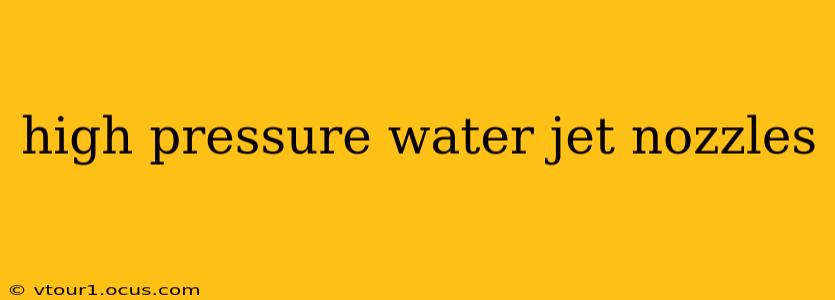High-pressure water jet nozzles are indispensable tools across a multitude of industries, from industrial cleaning to precise cutting and surface preparation. Their effectiveness stems from the focused, powerful stream of water they produce, capable of accomplishing tasks that would be difficult or impossible using traditional methods. This comprehensive guide explores the intricacies of these powerful devices, delving into their applications, types, and key considerations for selection and maintenance.
What are the Different Types of High-Pressure Water Jet Nozzles?
High-pressure water jet nozzles come in a wide array of designs, each tailored to specific applications. The choice depends heavily on the desired outcome, the material being worked on, and the pressure of the water jet system. Common types include:
-
Rotating Nozzles: These nozzles utilize a rotating head to distribute the water jet in a circular pattern, offering increased cleaning efficiency over a wider area. They are particularly useful for cleaning large surfaces like tanks or shipping containers.
-
Fixed Nozzles: These nozzles provide a concentrated, straight stream of water, ideal for tasks requiring precise cutting or material removal. Their focused power makes them suitable for applications such as cutting concrete or cleaning intricate machinery.
-
Fan Nozzles: Producing a flat, fan-shaped spray, these nozzles are well-suited for cleaning larger areas while providing a gentler impact compared to a direct stream. They are commonly used in industrial cleaning and agricultural applications.
-
Pencil Nozzles: These nozzles offer the most concentrated stream, providing the highest cutting power but with a smaller working area. They're often utilized for very precise tasks and intricate detailing.
What are the Applications of High-Pressure Water Jet Nozzles?
The versatility of high-pressure water jet nozzles makes them invaluable across various sectors:
-
Industrial Cleaning: Removing stubborn grime, paint, rust, and other contaminants from a wide range of surfaces. This includes cleaning machinery, tanks, ships, and building exteriors.
-
Surface Preparation: Preparing surfaces for subsequent processes like painting, welding, or coating by removing old paint, rust, and other imperfections.
-
Cutting and Demolishing: Precisely cutting through various materials like concrete, steel, and stone. This is particularly useful in demolition, where the precise nature of the water jet allows for controlled material removal.
-
Mining and Quarrying: Extracting minerals and preparing materials for further processing.
-
Oil and Gas Industry: Cleaning equipment and pipelines, and even aiding in well stimulation processes.
How Do I Choose the Right High-Pressure Water Jet Nozzle?
Selecting the appropriate nozzle depends on several crucial factors:
-
Pressure Rating: The nozzle must be compatible with the pressure of your water jet system. Using an incorrectly rated nozzle can lead to damage or malfunction.
-
Flow Rate: The desired flow rate dictates the cleaning efficiency and cutting power.
-
Spray Pattern: The required spray pattern (rotating, fixed, fan, pencil) is crucial for determining the best nozzle for the job.
-
Material Compatibility: Consider the material being worked on to ensure the nozzle is compatible and won't be damaged.
What are the Safety Precautions When Using High-Pressure Water Jet Nozzles?
High-pressure water jet nozzles are powerful tools and require strict adherence to safety protocols:
-
Eye Protection: Always wear appropriate eye protection to avoid potential injury from high-velocity water droplets.
-
Hearing Protection: The high-pressure water jet can produce significant noise, requiring hearing protection.
-
Protective Clothing: Wear protective clothing to shield the skin from the high-pressure water stream.
-
Training: Proper training on the safe operation and maintenance of the equipment is essential.
How Do I Maintain High-Pressure Water Jet Nozzles?
Regular maintenance is vital for extending the lifespan and ensuring the optimal performance of your nozzles:
-
Regular Inspection: Inspect the nozzle for any signs of wear, damage, or clogging.
-
Cleaning: Clean the nozzle regularly to remove any debris that might obstruct the water flow.
-
Storage: Store the nozzle properly to prevent damage or corrosion.
What are the Different Materials Used in High-Pressure Water Jet Nozzles?
High-pressure water jet nozzles are typically manufactured from durable materials such as:
-
Tungsten Carbide: Known for its exceptional hardness and abrasion resistance, making it ideal for demanding applications.
-
Steel: A common and versatile material offering a good balance of strength and cost-effectiveness.
-
Ceramic: Offers excellent resistance to wear and corrosion, but may be more fragile than other materials.
This information provides a foundational understanding of high-pressure water jet nozzles. Remember that specific requirements will vary depending on your individual application. Always consult with a specialist to ensure you select the right nozzle for your needs and operate it safely.
